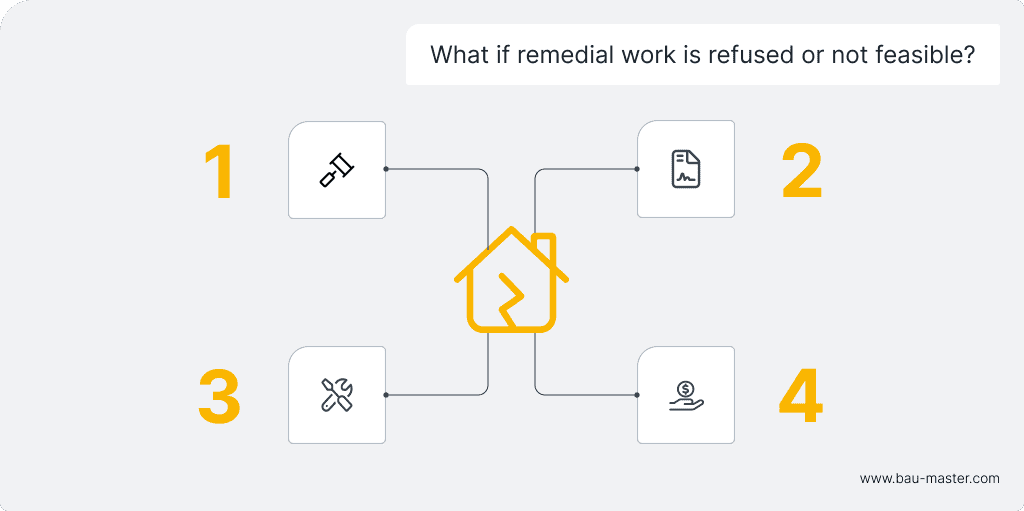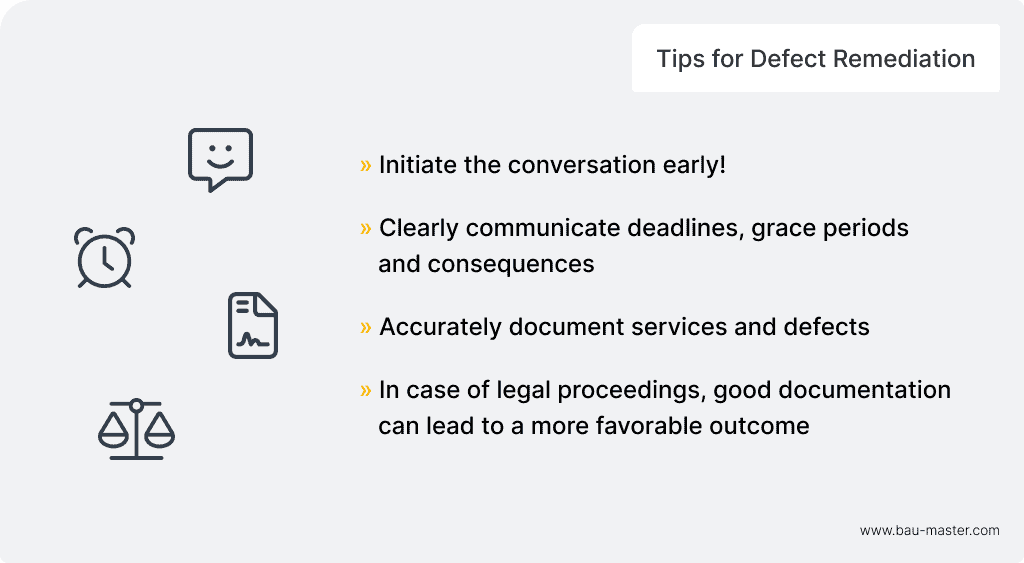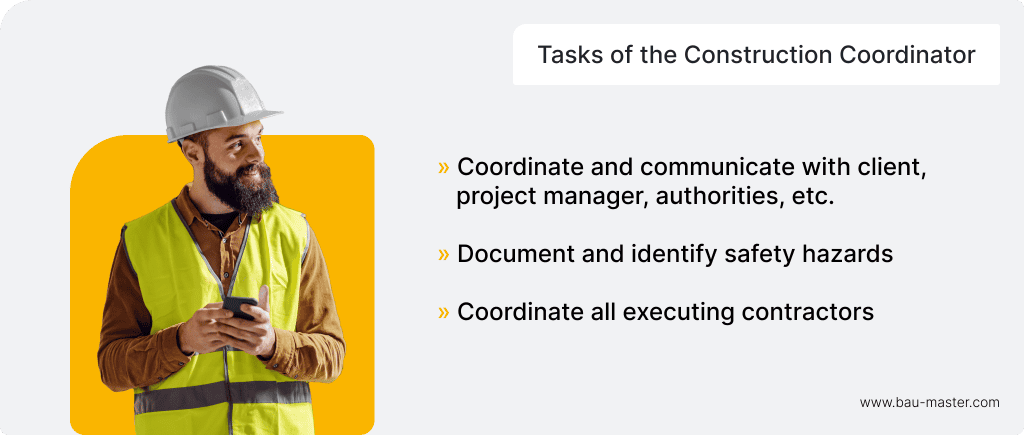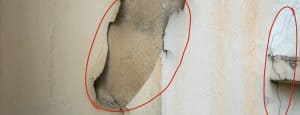Remedial works are a key concern for everyone involved in construction. Whether you’re an architect, a contractor, or a site manager, the goal is the same: to resolve defects quickly and keep the project on track. But what qualifies as remedial work? How can you ensure a smooth process? And what happens if requested repairs are delayed – or unreasonable?
This guide provides clear answers for architects, site managers and contractors alike.
- What is remedial work?
- When are remediation works necessary?
- Common construction defects
- How to handle remedial works as a site manager or architect
- The meaning of remedial work for contractors
- Collaborative remedial management with digital solutions
- Modern remedial work is safe, fast and efficient
- FAQ – Frequently asked questions on remedial works
Remedial works at a glance
What does remedial work mean?
Remedial work refers to corrective action taken by the contractor to fix construction defects, ensuring the building meets safety and contract standards.
When is remediation necessary?
Remediation works are necessary when construction defects – whether minor or serious – breach contract terms or standards, including hidden faults that may surface later and lead to costly damage or legal disputes.
Best practices for site managers and architects:
Defects should be documented thoroughly, reported in writing with a clear deadline, and followed up with appropriate action if not resolved within the agreed timeframe.
Best practices for contractors:
Contractors decide how defects are fixed and should communicate proactively, document all actions, and seek partial payment during ongoing remediation.
What is remedial work?
Remedial work – or remedial works – are corrective measures taken to fix construction defects or safety issues. The goal is to restore the building or component to a safe, functional, and contractually compliant condition. The scope is wide, ranging from structural repairs to fixing substandard workmanship or addressing safety concerns.
The client or site manager has the right to request remediation if defects are identified during construction or within the defect liability period (typically 12 months after completion). Faults must be reported to the responsible contractor, who is obliged to rectify them.
However, if remedial work is refused or not feasible, you may consider these alternatives:

When are remediation works necessary?
Remedial works are required whenever construction deviates from the contract, building regulations, or accepted industry standards. The responsible contractor must correct any defects resulting from their work.
Depending on the severity, corrections may range from minor fixes – like replacing faulty fixtures – to major structural elements or addressing building safety issues (e.g. inadequate fire protection). Such major defects might even render the building unusable if ignored.
Additionally, not all issues appear right away. Latent defects may remain hidden for months or years, potentially causing significant damage. They often lead to disputes between contractors and clients, and are a common cause of legal action in construction.
Common construction defects
Defects typically arise from design flaws, poor workmanship, material failures, or environmental exposure. Common examples include:
How to handle remedial works as a site manager or architect
For site managers, architects, or civil engineers, properly documenting and reporting defects is essential. This ensures protection in case contractors do not meet their obligations. Here are the most important steps:
What to do if a defect is found before handover
Before project handover, conduct regular site inspections, document all defects with photos, and maintain clear and structured records. This allows you to address open issues promptly and helps to manage latent defects later on.
Additionally, pay close attention during handover – obvious defects must be reported at that stage, or the opportunity to claim them may be lost.
How to report defects
There are two important principles to consider when reporting defects:
Setting a reasonable deadline
The appropriate deadline for remedial works depends on the severity of the defect. Minor issues can often be resolved within a few hours, while serious defects that affect the structural integrity of a building may require weeks or even months to rectify.
Rule of thumb: how long should the deadline be?
A reasonable timeframe for remedial works is typically 14 days. For faults that can be quickly resolved, a shorter period may suffice. For significant issues, the deadline may need to be extended to several weeks or months.
Preparatory time and special circumstances must also be taken into account, such as delivery times for additional materials.
How to approach remedial works after handover
The remediation process remains the same, but once the project has been completed, enforcing it becomes more challenging. Notification of defects is only possible within the defect liability period, and only for latent defects – those that were not reasonably detectable at the time of completion.
However, deliberately concealed issues are typically exempt from this rule. In such cases, it may still be possible to assert claims even beyond the standard liability period.
What if the contractor ignores the defect notification?
Even if defects have been clearly documented and communicated, contractors may still fail to respond. If the deadline passes without any action, it is customary to allow one final grace period.
Follow up with a written reminder, stating that if no action is taken, the defect will be resolved by another contractor at the original contractor’s expense. If there’s still no response, proceed with the repair and reclaim the costs.
Follow up with a written reminder, stating that if no action is taken, the defect will be resolved by another contractor at the original contractor’s expense. If there’s still no response, proceed with the repair and reclaim the costs.

The meaning of remedial work for contractors
For contractors, handling remedial works on-site often comes with several challenges: unjustified blame, unrealistic deadlines, and withheld payments. Here’s how to respond effectively:
Who decides how to remedy defects?
Can the project manager dictate how remedial work is carried out? In short: no. The contractor may choose whether to repair or replace a defective element. Also, if the cost of the proposed remediation is clearly disproportionate to the benefit, the contractor may be entitled to refuse it entirely and offer a price reduction instead.
What to do when the remedial deadline is too short?
The first step is to reach out proactively and explain the actual timeframe required to perform the corrections. The site manager or architect may not be aware of how much effort the work involves. If cooperation has gone well so far, you’re likely to find a workable solution.
Should the matter end up in court, it will be judged on a case-by-case basis. If you can clearly demonstrate that it was impossible to complete the work within the given timeframe, the decision is likely to be in your favour.
A well-structured documentation plays a key role in disputes and legal matters. Always keep detailed site logs and daily records!
Withheld payments: what is fair during ongoing remediation work?
Withholding the entire payment due to a defect is considered excessive and may breach fair payment provisions or contractual obligations. Doing so could quickly drive a contractor into financial difficulty.
Instead, both parties should aim for a fair and balanced solution. Partial payments can be agreed upon to reflect the value of the completed and undisputed works while the remediation is in progress.

Collaborative remedial management with digital solutions
In the midst of disputes over defective works, it is important to remember: site managers, architects, and contractors are not adversaries. Construction projects succeed when all parties work hand in hand.
Efficient teamwork on-site includes structured workflows and close coordination. This is achieved easily with modern digital tools. Such platforms centralise project information, streamline communication, and allow real-time updates on remedial works.
A practical example of construction defect management with BauMaster:
1. The site manager documents the defect.
The site manager notices a missing transition strip between parquet and tiles during a site inspection and logs the issue in the BauMaster app – with location, photos, and a deadline. The task is created in under 30 seconds and assigned to the responsible contractor.
2. The contractor sees the task on their dashboard.
The contractor views the task details, confirms receipt, and proceeds with the corrective action. Once complete, they upload proof and mark the task as “ready for review.” The site manager is automatically notified.
3. The site manager confirms completion.
The site manager briefly checks whether the issue has been resolved and marks the task as “completed.” Both parties can now seamlessly return to their daily operations. Tasks can be filtered by status, both within the project and across multiple projects. This creates comprehensive defect reports – for the whole project or individual trades.
4. The task is completed with full transparency.
Everyone stays informed, without endless phone calls or back-and-forth messages. The process is transparent, efficient, and fully documented – providing a reliable record if questions arise later.
Modern remedial work is safe, fast and efficient
Defects are a normal part of any construction project – even the most careful contractor can make a mistake. But by following the best practices outlined in this guide and relying on collaborative digital tools, it is possible to handle any issue constructively and without delay. In the end, it is the joint commitment of all project partners that ensures a successful outcome.
FAQ – Frequently asked questions on remedial works
What is an example of remedial work?
A common example of remedial work in construction is repairing a leaking flat roof that was improperly sealed during installation. Other examples include fixing cracks in masonry, replacing faulty electrical components, or correcting fire safety deficiencies such as improperly installed fire doors.
How often should I send a defect notice?
At least one written notice should be issued. If the contractor does not respond, a follow-up with an extended deadline is advisable before proceeding with alternative remedies or legal action.
How often can a contractor carry out remedial works?
Depending on the complexity of the issue, a contractor may be allowed more than one attempt to remedy a defect. What matters is whether both parties can agree on the quality and accept the outcome as sufficient. Sometimes it is more practical to stop remediation attempts and agree on alternative compensation, such as a price reduction.










